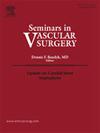引导老年人CLTI的治疗决策:原发性截肢与血运重建术
IF 2.4
3区 医学
Q1 PERIPHERAL VASCULAR DISEASE
引用次数: 0
摘要
随着世界老年人口的持续增长,慢性病患者的比例也在增加。包括高血压、糖尿病和动脉粥样硬化在内的心血管疾病是最常见的,因此外周动脉疾病(PAD)在这一人群中越来越普遍。据估计,老年人群中有15% - 20%被诊断为PAD,因此也有很大比例的人发展为慢性肢体威胁缺血(CLTI)。无论年龄大小,晚期PAD的治疗都很复杂,因为目前的实践模式存在很大的差异,并且对血管内或手术旁路治疗作为初始治疗方式缺乏共识。在老年人群中,治疗模式变得更加复杂,必须特别考虑治疗,包括决定提供血运重建术(手术或血管内)还是原发性截肢。本文探讨了这两种方法在老年人死亡率、生活质量和成本方面的风险和收益。虽然有充分的证据表明,血运重建术在死亡率、生活质量和成本方面都有好处,但也有数据表明,这种方法只应提供给完全独立的个体,因为术前不能走动的患者预后较差。总的来说,作者提倡以患者为中心,多学科的方法来治疗CLTI,首先关注患者的目标。本文章由计算机程序翻译,如有差异,请以英文原文为准。
Navigating treatment decisions for CLTI in older adults: Primary amputation vs revascularization
As the world’s elderly population continues to grow, the proportion of people living with chronic medical conditions is also increasing. Cardiovascular diseases including hypertension, diabetes, and atherosclerosis are among the most common, and as a result peripheral artery disease (PAD) is increasingly prevalent in this population. It is estimated that 15% to 20% of the elderly population has been diagnosed with PAD, and consequentially there is also a large proportion who have progressed to chronic limb threatening ischemia (CLTI). The management of this end stage of PAD is complex regardless of age, as there is high variability in current practice patterns and a lack of consensus on endovascular or surgical bypass as the initial treatment modality. The treatment paradigm becomes even more complicated in the elderly population, and special considerations must be given to treatment including the decision to offer revascularization (surgical or endovascular) vs primary amputation. This article explores the risks and benefits of the 2 approaches in the context of mortality, quality of life, and cost in the elderly population. Although there is good evidence that revascularization confers benefits in mortality, quality of life, and cost, there are also data that indicate that this approach should only be offered to fully independent individuals as outcomes in those with a nonambulatory status preoperatively are poor. Overall, the authors advocate for a patient-centered, multidisciplinary approach to treating CLTI in this population that focuses first and foremost on patient goals.
求助全文
通过发布文献求助,成功后即可免费获取论文全文。
去求助
来源期刊
CiteScore
3.50
自引率
4.00%
发文量
54
审稿时长
50 days
期刊介绍:
Each issue of Seminars in Vascular Surgery examines the latest thinking on a particular clinical problem and features new diagnostic and operative techniques. The journal allows practitioners to expand their capabilities and to keep pace with the most rapidly evolving areas of surgery.

 求助内容:
求助内容: 应助结果提醒方式:
应助结果提醒方式:


